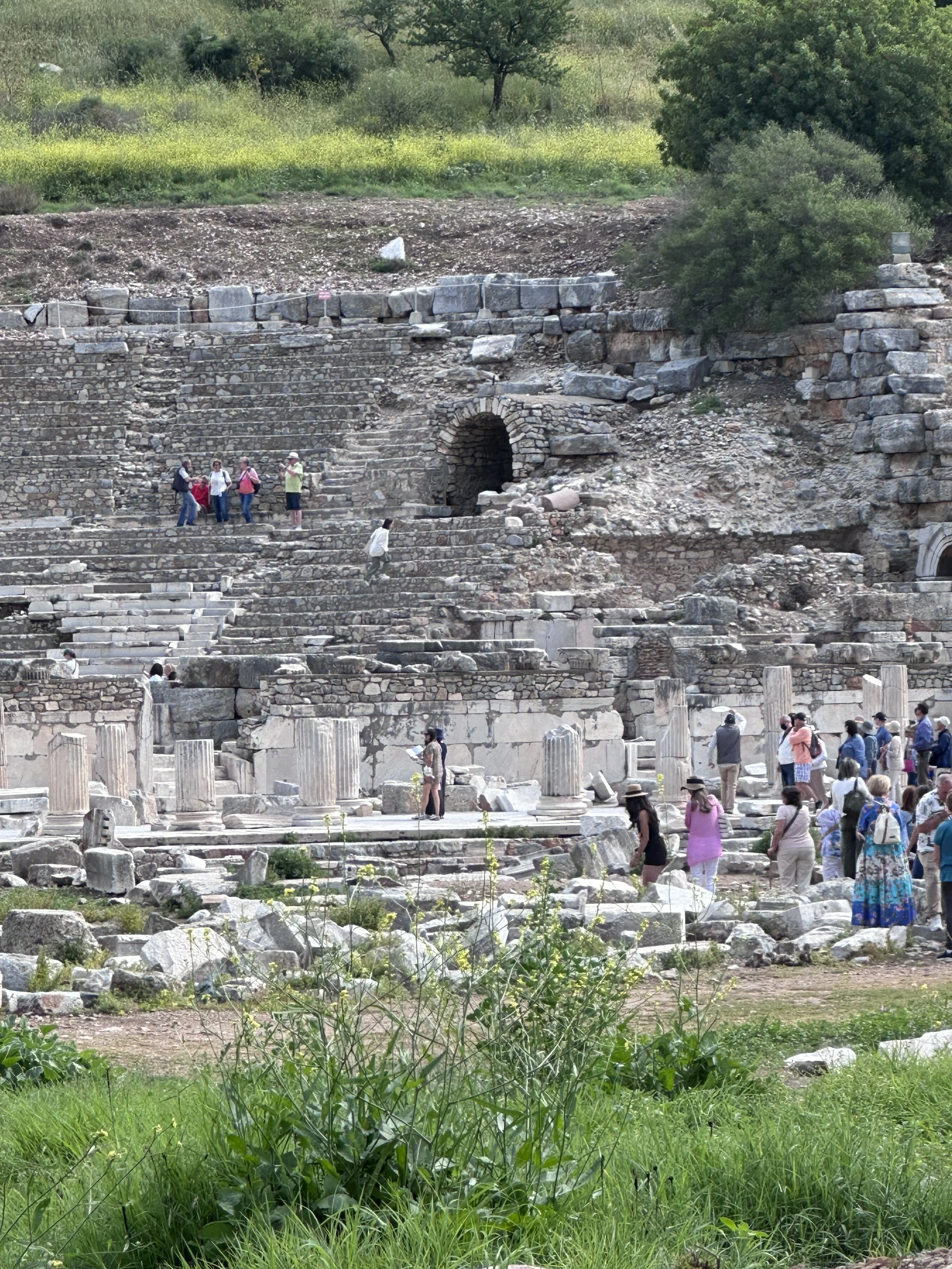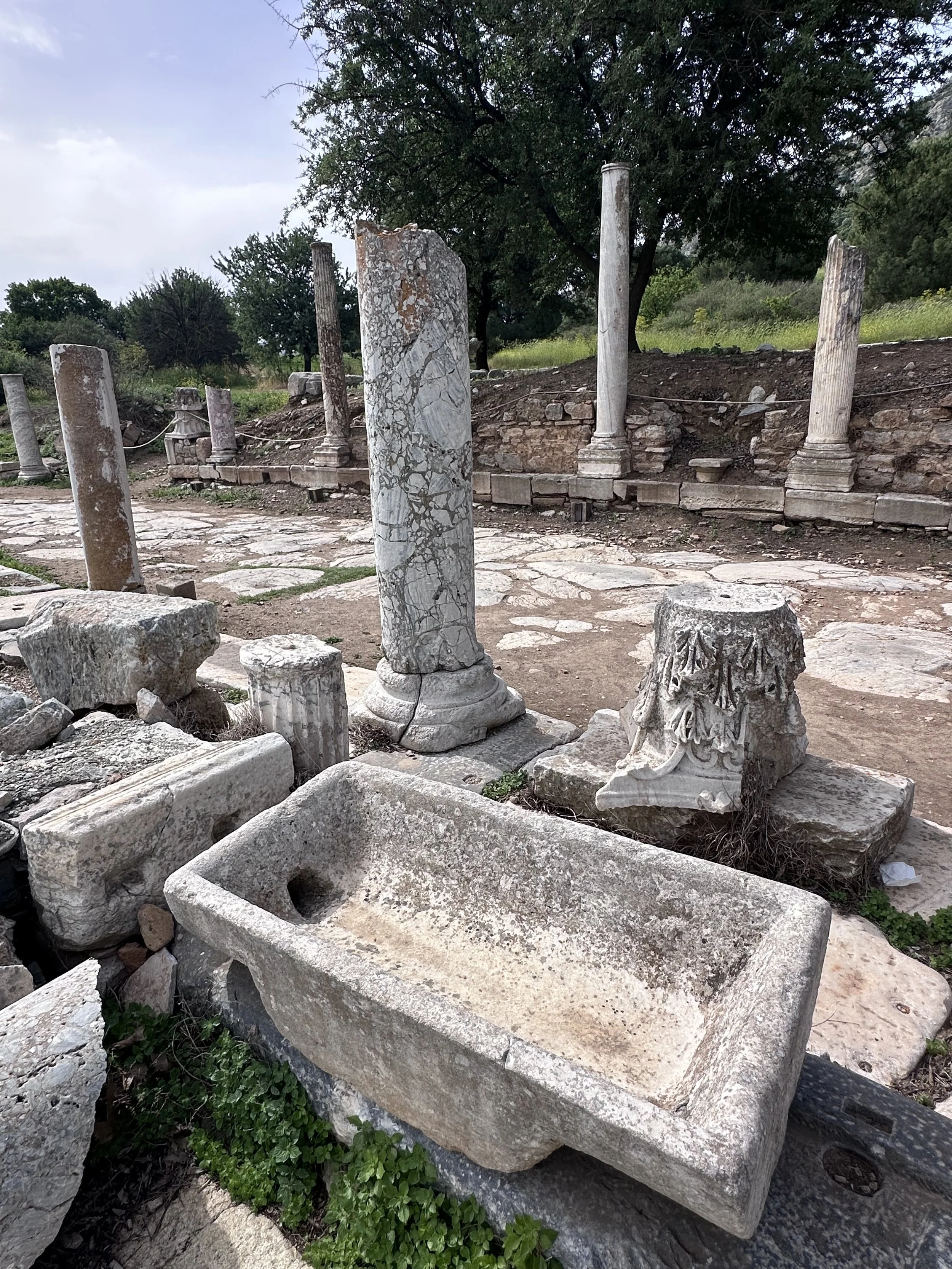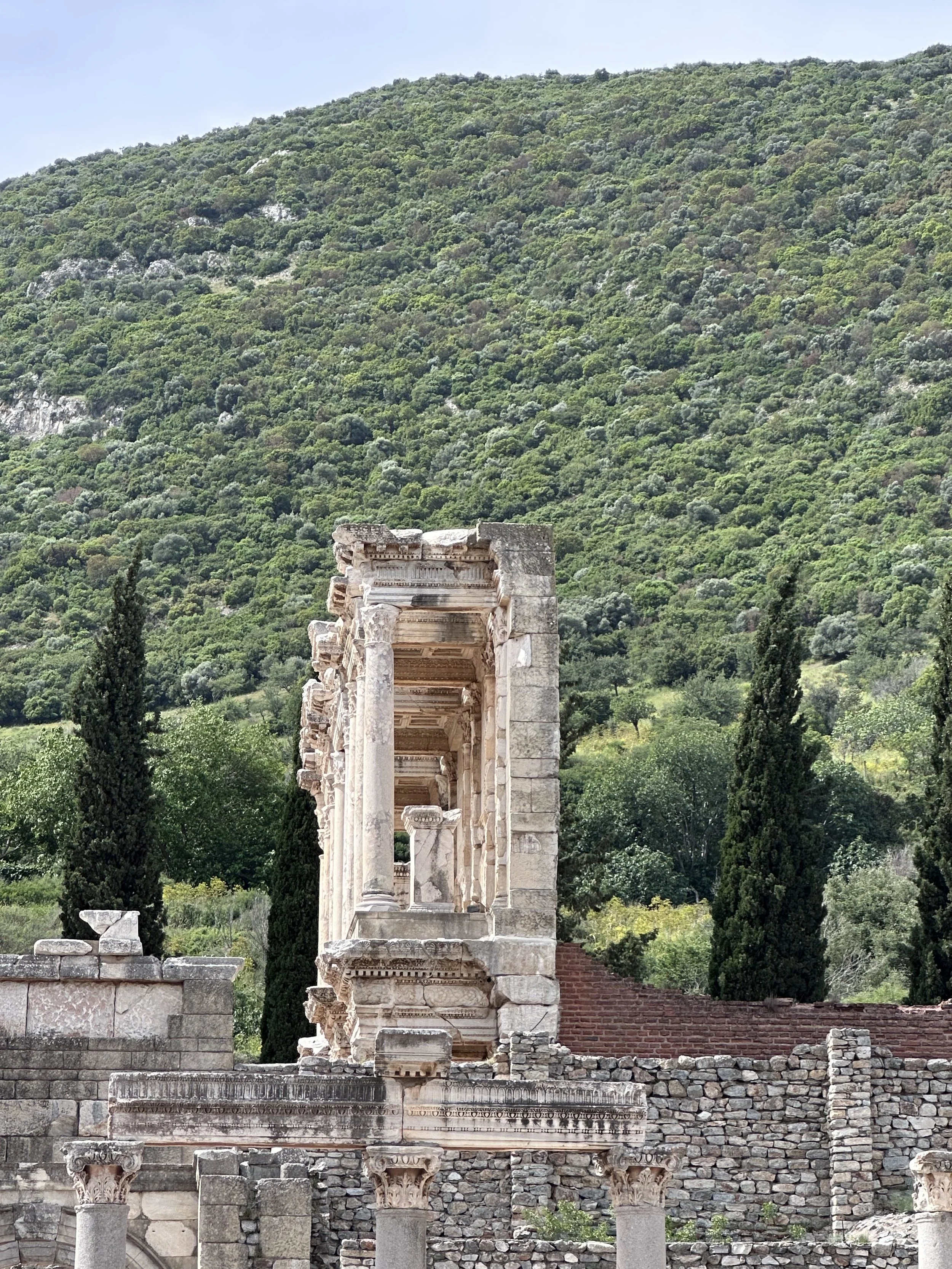Exciting Ephesus, Turkey: (Late Post from May 6)
Leaving the ship, we walked through the duty-free shops. There was no other way out. Once to the street, it was chaos! So many people… signs with names… At first, we didn’t see our names anywhere. Then I noticed a lady off to the side with a sign waiting for a cruiser to join her tour. In addition to the passenger’s name, I saw “Moira Travel”. That was the name on my confirmation slip, so I asked her where we were supposed to meet our guide. She made a phone call and joined us with our leader.
As with most cruise tours, there is an obligatory visit to some sort of vendor. On this trip, it was actually quite interesting. Not that there was a chance in the world either of us was going to buy a rug, but to see the process was fascinating. Cocoons produced by silkworms soften in tubs of water. Once they are soft, the lady begins pulling silk string out. Long, very long strings were gathered.
Along one wall several women sat on low stools weaving the rugs. All the needed colors of yarn placed conveniently above the loom. Mounted below the yarn was the pattern. Quite intricate, I don’t know how they kept track of where they were in the process. Depending on the size of the rug and the material (silk, cotton or wool), it can take several weeks to several months for these masterpieces to be created!
So many colors and designs! At least six rooms that I noticed right off the bat had walls full of the completed rugs. We learned so much about how to determine the value of a particular rug. To be honest, I fell in love with a couple of them. Having lost my Persian rugs in Hurricane Harvey, I am drawn to this particular art form. My Mother-in-Law, Ruth gave me a couple… she had quite a collection!
Back in the van with our guide Memo, he used a few tricks to bypass the long lines and crowds. That’s the benefit of booking a local, professional tour guide. Rather than following the tens of busses, we went to the top of a hill and worked our way backwards through the ancient grounds. What a treat this portion of the tour was!
Located on the slope of Panayir Hill, there is conflicting information as to when the theater’s construction first began. Everything I read agreed building began during the Hellenistic period, under the rule of Lysimachus. It’s the exact time period that is vastly different. Sources state dates as far back as 250 BC and as recent as 3 BC. But most agree that around 35-45 AD, the Romans enlarged the theater. Seating 25,000, our guide told us that generally speaking, the population of an area could be determined by the size of the theater. Ten times the seating gave an accurate number of citizens residing in Ephesus during that time period.
What an incredible feeling to walk the “streets” with such long history! With excavators constantly working to dig up this lost city, three main streets have currently been cleared and restored. Pictured here is Harbor Street… the grand boulevard. Once used by travelers from all over the Roman Empire. Picture this… common sailors and merchants walked this street but so did Marc Anthony and Cleopatra!
Digging up the relics of centuries past, this relief of the Goddess of Nike was exposed. Nike is the Greek goddess of victory.. Created in the 4th and 5th century, Nike holds a palm in her right hand and a wreath of laurel leaves in her left hand. Dressed in a flowing gown, Nike had the ability to run and fly very fast. It is not a coincidence that the shoe founder, Phil Knight, named is company Nike.
Named after the Roman Emperor Hadrian, the arches are located where Curetes Street and Marble Street join together. The Temple of Hadrian remains were unearthed in 1956 by the Austrian Archeological Institute. Surprisingly well preserved, a few modern supplies were used to recreate the original effectively.
Made of marble, this statue was dedicated to a female doctor who had provided exceptional service in Ephesus. Found in the midst of ruins, it is now proudly displayed on Curetes Street. As we walked by, I noticed this cat comfortably resting in the shade of the relic.
Often missed by tourists, this wheel can be found around the Ephesus area. In an effort to protect Christians from prosecution, secret symbols were used. A fish with the letters IXOYE represented a follower of Christ. Transposing the letters, the wheel above can be formed. By starting to write the letters, a Christian would immediately recognize and identify themselves as a believer.
Absolutely amazing the number of treasures being unearthed in this UNESCO site! Slowly experts are piecing together the items found. With much research, archeologists are able to recreate the streets of Ephesus.
Centuries ago, vendors set up shops on this fancy street. With an intricate tile pathway, this is where all the fancy stores were located. Each opening in the wall was a separate entrance. My mind wandered … trying to picture people walking these streets dressed in tradition clothing.
Imagine… all of these artifacts, the walls and statues were buried under dirt. Erosion from the nearby mountains slowly filled in the valley below. This was explained as the reason the ships dock in Kusadasi instead of Ephesus. That port is far away by land now. In these photos, you can see bricks, rocks and arches still intact. Our guide, Memo, suggested we return in five to ten years because so much progress is being made. More historical pieces will be unearthed in the years to come.
First sight… the third largest library in ancient times, The Celcus Library was built in 2AD. Proudly standing as a tribute to a prominent Roman consul and former governor of the Asian province, Tiberius Julius Celsus Polmaeanus. He had the architecture commissioned the library as a mausoleum for his father.
Pretty impressive… our skilled guide had us stand in a particular spot that would avoid the massive crowds. You really can’t tell that we are surrounded by hundreds of tourists exploring this area. Walking down the path to the actual structure, Memo told us an interesting “fun fact”. From our viewing spot, there are pathways on either side of us. Back in ancient times, husbands would escort their wives to the library… then they would take tunnels underneath the plaza area and library. What might be there to keep them entertained? Brothels.
What a magnificent structure! Intricate carvings adorn the outside of the library. The outside facade is held up by four columns. Each section has a Corinthian capital; Statue of wisdom (Sophia), knowledge (Episteme), intelligence (Ennoia), and virtue (Arete). At one point in time, the library housed thousands of scrolls. They have since disappeared but the building still stands!
After walking through the arches attached to the Celsus Library, we entered the first section of the Agora… the State Agora. Once the central hub for commerce, politics and social gatherings. The State Agora was mainly used for political and public meetings. Also, the photo on the left is the Library from a side perspective… apparently, marble really does stand the test of time (and the elements).
Meandering down the slippery marble pathway, we were introduced to Garfield of Ephesus… he actually has his own Instagram account (@garfield_of_ephesus). Imagine living amongst the centuries old, biblical ruins. Spoiled every day, all day… Garfield is absolutely comfortable with strange humans…
Heading toward the normal entrance (which was our exit since we went backwards), we saw the tail end of a full costume re-enactment of life during in ancient Ephesus! It really brought the whole experience to life!
Here’s another “fun fact”… the country of Turkey has a sensational rescue program. In an effort to take control of the stray dog problem, several organizations joined together to tag stray dogs. This lets the general public know that the dog has been examined, vaccinated and released. Each dog has a health file. Once released, kind people take over feeding the strays. Often times someone will volunteer to collect donations and purchase large amounts of dog food. The animals begin to realize the twice a day feeding schedule and know just where to meet the feeder.
After exploring the ancient area of Ephesus, Memo took us to visit Virgin Mary’s last known residence. Cleverly named “House of the Virgin Mary”… this is now a Catholic shrine. It literally takes 10 seconds to walk through but we lingered a bit longer. Looking at rosary beads gifted by former Popes, nicely framed and labeled. The grounds are peacefully set in a forest on Mt Koressos. To the left of the small stone home is a beautiful prayer area.
No photographs were allowed inside the dwelling… I accidentally took this shot before I knew the rules. It really gives nothing away as to the interior of the home. Immediately upon walking through the door, we saw a wood burning heat source. Not really a fireplace and definitely not a woodburning stove… this was a place to burn wood and keep the small area warm in the cold winter months. The residence has just enough room to cook, eat and sleep. This very efficient structure must have been easy to heat considering it was made of stone and had only two windows. There was a front and back door allowing us to walk through.
Just outside of Mary’s House, a path leads to healing fountains. Fed from a stream up above, waters flow into three separate fountains. People come from far and wide to drink from these fountains. Some bring bottles to fill and take water home with them. You can light a candle, say a prayer and be blessed by the waters. It is said to come from a stream of Holy Water and can provide spiritual, physical and financial healing. You can either go directly to one, if your need is only for a single healing, or visit all three… they were quite busy while we were there! Very special…
On the right hand side is a Wishing Wall… what you are seeing are various sizes of paper with wishes written on them. Some long letters, others short and succinct requests. There are literally thousands of wishes… prayers… requests. Of course, we had to add ours to the wall! What an experience…
Still on the grounds of Mary’s House, we stopped at an outdoor cafe. Memo ordered Turkish coffee for us and provided instructions on how best to enjoy this very, very strong coffee! He shared that his mother is the only person he knows who drinks the cup dry. “Normal” people drink the liquid and leave the residual “mud” on the bottom of the cup. He wasn’t kidding! It was absolutely, the best (and strongest) coffee I’ve ever had but the bottom was like black tar heroin! It was, as he described, mud. I’m guessing, had I chosen to clean my cup, I would have gone into cardiac arrest…
Heading down Mt Koressos, we stopped for a quick photo of The Blessed Virgin Mary statue. Made of bronze, this large tribute to Mary was located on a simple turnoff of the highway. She looks out over a beautiful valley. The are is quite peaceful, despite traffic going to and from the shrine/house of Mary.
Standing before one of the Seven Wonders of the Ancient World, Memo gave us a brief explanation of its historical significance. First designed in 550BC, this single column is all that remains of the Temple of Artemis. Destroyed over the centuries by flood, earthquakes and a crazy arson, the remaining materials were used on several new constructions. Initially built as a Pagan facility, after one reconstruction, it transformed into a Christian house of worship. Fascinating piece of information… though considered a Christian temple, remaining materials were used on the Hagia Sophia and Blue Mosque in Istanbul. Closer to the temple, the Isa Bey Mosque, which overlooks the grounds of the Temple of Artemis, is build with some of the columns and marble.
As we had unknowingly booked a private tour, we covered a lot of ground in a shorter time than exploring with a bus full of people. Memo asked what we’d like to see next but we had really seen so much already! The heat of the day and the sensory overload had us ready to return to the safety of our ship. One last stop at the suggestion of our guide… a lookout point where we had a clear view of Majestic Princess. Also, a whimsical and colorful photo op with the name of our port, Kusadasi!
Driving through town, two artistic sculptures caught my eye. On the left is the “Hand of Peace”. Located in Ismail Cem Friendship and Peace Square, the hand holds black pigeons and a white dove. These represent peace and freedom… tranquility and harmony. On the right-side photo, this couple sits peacefully overlooking the harbor. He gives the appearance of a fisherman, I imagine she is his girl… After looking through the internet, I was unable to find any information on this piece. Seriously… I can’t be the only person who found this interesting!!!
After being dropped off, we realized we were starving. Of course, we could have gone back on the ship to eat for free… but we like to experience local food in every port. So, we found a seaside restaurant. It was amazing!!! With the Kusadasi sign on the hill in the background, we enjoyed a fun cocktail, delicious Turkish food and excellent service. What a treat!




























